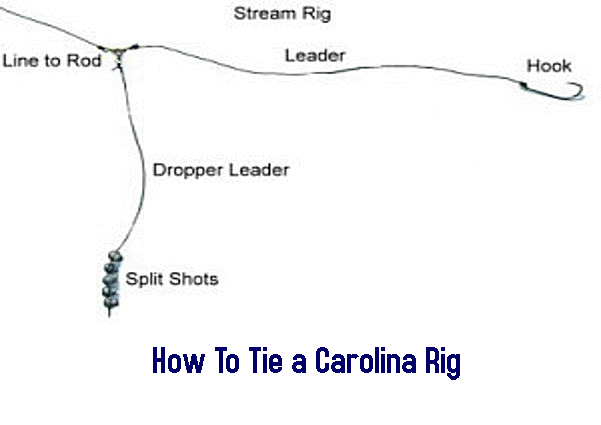THE CAROLINA RIG – BASS FISHING
Carolina rigging has become a well-respected method for catching large numbers of fish. A good Carolina rig can not only place well in a fishing event but can also make the difference of a win. The Carolina rig originated in South Carolina a few decades ago. It didn’t become popular until a man named, Jim Nolan used it to win a Bass Master’s tournament in 1991. Most of his record-breaking catch of 86 pounds and 6 ounces was caught using the Carolina rig. For his bait, he used a plastic lizard. One thing that is critical to remember when using the Carolina rig always uses a bait that floats.
The simplest Carolina Rig is a line with a weight and a bead attached to a barrel swivel than a leader and a hook. Now the fun part is that you can dress it up as much or as little as you like.
You should be using the rod in a dragging motion from side to side to move your bait. If you get a strike halfway through your drag, then return to where you started at the same time keeping the line tight and set the hook.
You will need a half ounce bullet sinker are heavier with a barrel swivel. Some people use a glass bead to protect the knot and swivel. You will need a wide band, locking style hook. The bigger your bait, the bigger your hook will need to be. You will slide your sinker onto the end of your line, and then your glass bead, and then tie on your barrel swivel. At the end of your swivel, tie a three-foot leader. And at the end of your leader tie your hook and apply your bait.
This technique is often referred to as dragging. This explains it well, once you cast, wait till your sinker hits bottom and retrieve your bait with slow drags. Sometimes, just setting your pole down, not even dragging your bait can provoke a strike. For bass, use a plastic lizard or a plastic worm. However, this technique can be used for trout, walleye, or even panfish.
When fishing the Carolina Rig for bass, don’t throw it in heavy, dense weed beds. It works better in sparse weed beds or just outside of heavy weed beds. You can also use it to fish the base of structures. This technique is designed to catch fish that are feeding on the bottom.
This technique is simple and very effective. It’s not hard to master, and it will put fish in the boat in a hurry. When fish are feeding on the bottom, it puts your bait right in the strike zone and keeps it there. The hardest part is learning how to tie the rig. You will also need a bigger hook set because of the way it’s rigged. A long fishing rod works great for the Carolina rig. You will have a hard time setting the hook with the short flipping stick.

The Carolina rig excels in current and sparse cover. When it comes to catfishing, the Carolina rig is perfect for suspended presentations. When you want to decide how much distance you want your hook to be of your weight, focus on two things. How thick is the cover and how fast is the current?
If the cover is really thick, you run the risk of your live bait swimming into the cover and getting tangled. If you get a big catfish to bite like this, you will struggle to pull him out of there. A short leader line will reduce the chances of this happen and will give you more control over the location of your bait.
The current will affect how well a catfish can grab the bait. In current, a carolina rig will have the bait swaying wildly in the water. A 2 foot leader will sway more wildly than a 6 inch leader. In heavy current a catfish will have trouble trying to catch that bait on longer leaders. To reduce this problem, we will down size the leader.
When you have super heavy cover or a strong current, a leader of 6 inches is your best option. When you have sparse and medium current, use 1 foot to 1 and a half feet. And for little to no current or cover, you may use a long 2-3 foot leader.